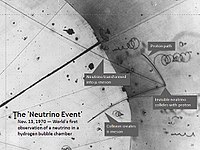
Photo from wikipedia
A bstractWe probe for evidence of invisible neutrino decay in the latest NOvA and T2K data. It is seen that both NOvA and T2K data sets are better fitted when… Click to show full abstract
A bstractWe probe for evidence of invisible neutrino decay in the latest NOvA and T2K data. It is seen that both NOvA and T2K data sets are better fitted when one allows for invisible neutrino decay. We consider a scenario where only the third neutrino mass eigenstate ν3 is unstable and decays into invisible components. The best-fit value for the ν3 lifetime is obtained as τ3/m3 = 3.16 × 10−12 s/eV from the analysis of the NOvA neutrino data and τ3/m3 = 1.0×10−11 s/eV from the analysis of the T2K neutrino and anti-neutrino data. The combined analysis of NOvA and T2K gives τ3/m3 = 5.01 × 10−12 s/eV as the best-fit lifetime. However, the statistical significance for this preference is weak with the no-decay hypothesis still allowed at close to 1.5σ C.L. from the combined data sets, while the two experiment individually are consistent with no-decay even at the 1σ C.L. At 3σ C.L., the NOvA and T2K data give a lower limit on the neutrino lifetime of τ3/m3 is τ3/m3 ≥ 7.22 × 10−13 s/eV and τ3/m3 ≥ 1.41 × 10−12 s/eV, respectively, while NOvA and T2K combined constrain τ3/m3 ≥ 1.50 × 10−12 s/eV. We also show that in presence of decay the best-fit value in the sin2θ23 vs. Δm322 plane changes significantly and the allowed regions increase significantly towards higher sin2θ23.
Journal Title: Journal of High Energy Physics
Year Published: 2018
Link to full text (if available)
Share on Social Media: Sign Up to like & get
recommendations!